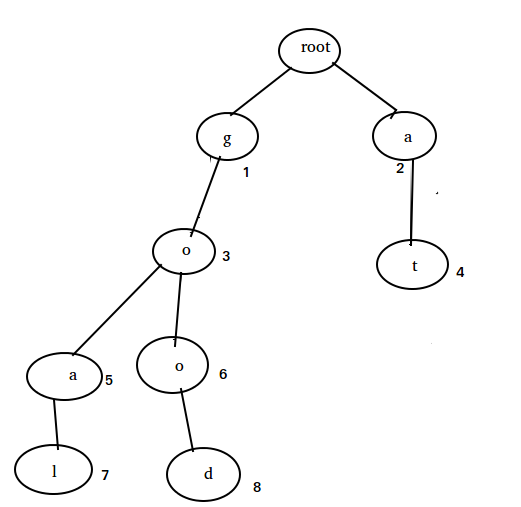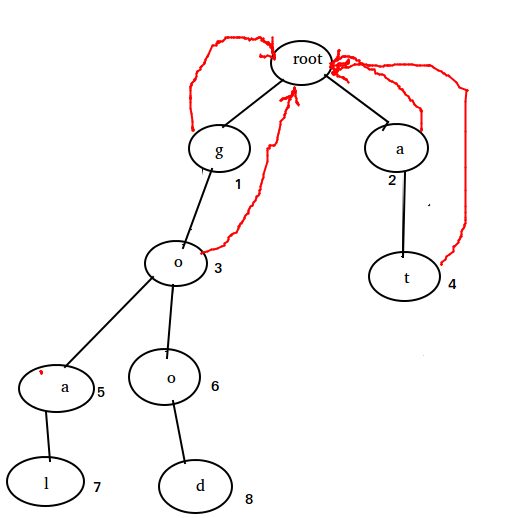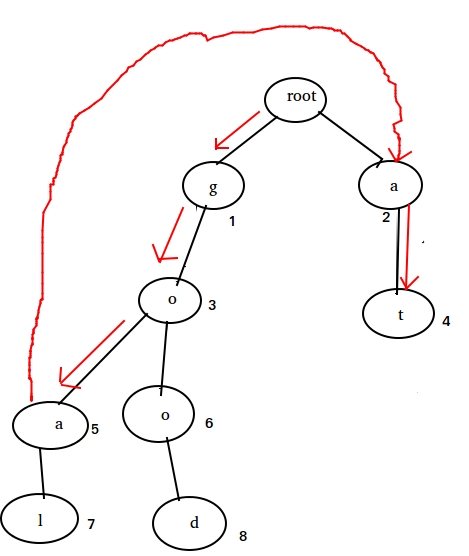L:“shit”“fuck”“you” “hide” “york”
S:“shideshitmeshitfuckyou”
输出:S中包含的L一个单词,要求这个单词只出现一次,如果有多个出现一次的,输出第一个这样的单词
怎么做?
字符串匹配问题。
暴力的话,用字典树保存L,剩下来就是暴力破解了
构建字典树O(n_l), 暴力法的话,最多复杂度为:
最近看AC自动机,其实这道题也是可以用AC自动机解决, 代码如下:
#include "stdio.h"
#include "string.h"
#define MAX_WORD_LEN 51
struct node{
node *next[26];
node *fail;
bool isRead;
bool isWord;
int length;
node() {
isRead = false;
isWord = false;
fail = NULL;
length = 0;
for (int i = 0; i < 26; i++)
next[i] = NULL;
}
};
node* q[MAX_WORD_LEN];
node *root;
int head, tail;
void insert(char *str) {
int len = strlen(str);
node *p = root;
int index;
for (int i = 0; i < len; i++) {
index = str[i] - 'a';
if (p->next[index] == NULL)
p->next[index] = new node();
p->next[index]->length = p->length + 1;
p = p->next[index];
}
p->isWord = true;
}
void build_ac(){
q[tail++] = root;
node *p, *temp;
while (head != tail) {
p = q[head++];
for (int i = 0; i < 26; i++) {
if (p->next[i] != NULL) {
if (p == root) {
p->next[i]->fail = root;
} else {
temp = p->fail;
while (temp != NULL && temp->next[i] == NULL)
temp = temp->fail;
if (temp == NULL)
p->next[i]->fail = root;
else
p->next[i]->fail = temp->next[i];
}
q[tail++] = p->next[i];
}
}
}
}
void sensitify(char *str, int begin, int size) {
// printf("%s, %d, %d\n", str, begin, size);
int len = strlen(str);
int end = begin + size;
while (end < len && begin < end) {
str[begin++] = '*';
}
}
void dealStr(char *str) {
int len = strlen(str);
node *p = root; // init status as root
int index = 0;
for (int i = 0; i < len; i++) {
index = str[i] - 'a';
while (p != NULL && p->next[index] == NULL)
p = p->fail;
if (p == NULL) {
// root->fail = NULL, this means current chars cannot be accepted as any word.
// reset the status as root.
p = root;
} else { // p->next[index] != NULL which means current status can accept this char.
p = p->next[index]; // accept this char
node *temp = p;
while (temp != root) {
if (temp->isWord) {
if (!temp->isRead)
temp->isRead = true;
else {
int size = temp->length;
int beginIndex = i - size + 1;
sensitify(str, beginIndex, size);
}
}
temp = temp->fail; //this is the longest match, and some times we could not find uck in fuck, so we need to check fail pointer recursively
}
}
}
}
int main(){
int ncase, num;
// scanf("%d", &ncase);
ncase = 1;
char keyword[51];
char str[1024];
while(ncase --) {
head = tail = 0;
root = new node();
scanf("%d", &num);
for (int i = 0; i < num; i++) {
scanf("%s", keyword);
insert(keyword);
}
build_ac();
scanf("%s", str);
dealStr(str);
printf("%s\n", str);
}
}
结果如下:
首先介绍一下字典树,形如下图:

经常用于字符串的查找。具体代码为:
void insert(char *str) {
int len = strlen(str);
node *p = root;
int index;
for (int i = 0; i < len; i++) {
index = str[i] - 'a';
if (p->next[index] == NULL)
p->next[index] = new node();
p->next[index]->length = p->length + 1;
p = p->next[index];
}
p->isWord = true;
}
其中 字符信息保存在 next[charIndex], 非空即为当前状态能接受该字符。或许将字符信息画在边上会更契合点。
接着是AC自动机
AC自动机的原理: 每一个节点都会有一个 fail 指针,表示当当前节点无法接受当前字符时,应该跳转的位置,一般为当前已接受字符的后缀式中能被AC机接受的字符串。通俗的来讲,当前字符串为goa时,后缀式“oa” “a”中“a”能被AC机接受(状态2)也就是状态5的 fail 指针应该是状态2. 如下图:
当输入字符串 input 为 goat 时,状态转至 5 时,由于当前状态无法处理字符 t,转到 fail 指针(状态2),查看是否能处理字符 t,正好能处理,进入状态4。这一过程读取 input 的指针并没有回退,也就是整个过程算法的时间复杂度为
具体代码:
void dealStr(char *str) {
int len = strlen(str);
node *p = root; // init status as root
int index = 0;
for (int i = 0; i < len; i++) {
index = str[i] - 'a';
while (p != NULL && p->next[index] == NULL)
p = p->fail;
if (p == NULL) {
// root->fail = NULL, this means current chars cannot be accepted as any word.
// reset the status as root.
p = root;
} else { // p->next[index] != NULL which means current status can accept this char.
p = p->next[index]; // accept this char
node *temp = p;
while (temp != root) {
if (temp->isWord) {
if (!temp->isRead)
temp->isRead = true;
else {
int size = temp->length;
int beginIndex = i - size + 1;
sensitify(str, beginIndex, size);
}
}
temp = temp->fail; //this is the longest match, and some times we could not find uck in fuck, so we need to check fail pointer recursively
}
}
}
}上面的 temp = temp->fail 的功能可以尝试把while 去掉, 尝试输入
2 fuck uck fuckersayfuuuckfuckyou
查看输出结果。
接下来是如何求 fail 指针。这里面要处理的问题是:
1) 确保失配时,跳转的 fail 指针应该是最长匹配。
首先算法的基本框架是BFS。
详细代码是
void build_ac(){
q[tail++] = root;
node *p, *temp;
while (head != tail) {
p = q[head++];
for (int i = 0; i < 26; i++) {
if (p->next[i] != NULL) {
//TODO set p->next[i]->fail
q[tail++] = p->next[i];
}
}
}
}重点在设置 fail 指针:
if (p == root) {
p->next[i]->fail = root;
} else {
temp = p->fail;
while (temp != NULL && temp->next[i] == NULL)
temp = temp->fail;
if (temp == NULL)
p->next[i]->fail = root;
else //temp->next[i] != NULL which means temp can accept i just as p does.
p->next[i]->fail = temp->next[i];
} 首先 root 下的所有可接受字符的 fail 指针为自身。
接着其他字符的 fail 指针为递归遍历父指针的 fail 指针中 能够接受当前字符,如果实在没有,则指向 root,表示当前的字符串不存在能接受的 keyword,重置状态。
举个例子:

状态 3 i=a 的时候,查看状态 3 的 fail 指针 root,恰好能接受 i=a, 于是状态5 的 fail 指针指向状态 2.
其实 可以把一个节点的所有一系列(通过递归获取) fail 指针 看作状态机的同一个状态。感兴趣可以查看编译原理里面的状态转移。
那怎么确定当前取得的 fail 指针是最长匹配呢 比如 blue ue e , blue e 的 fail 指针应该指向 ue 的 e, 而不是 e 呢? 原因在他的父亲节点 u 的 fail 指针指向的是 ue 的 u,所以 blue 的 e fail 指针指向的是 ue 的 e, 同时 ue 的 e 指向的是 e 的 e。 好绕 0.0
后记:
字典树中使用 next[26] 来保存字符信息,有些浪费。如果关键字很稀疏的话,大部分的指针空闲,造成浪费。如果只用 node *next,char contant保存的话,每次查询的时候都需要遍历next,如果关键字很密集的话,时间开销过大
鸣谢带我入门的blog AC自动机算法


























 3万+
3万+

 被折叠的 条评论
为什么被折叠?
被折叠的 条评论
为什么被折叠?








